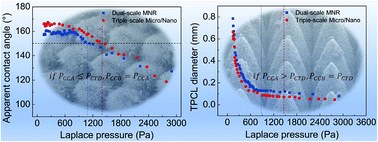Extremely high Cassie–Baxter state stability of superhydrophobic surfaces via precisely tunable dual-scale and triple-scale micro–nano structures†
Abstract
Superhydrophobic surfaces have been attracting considerable attention due to their potential applications in self-cleaning, anti-icing, water/oil separation, drag reduction, etc. However, to date, the problem of poor Cassie–Baxter (CB) state stability still remains a main reason constraining the commercialization applications of superhydrophobic surfaces. In the present study, we report a new type of superhydrophobic surface with tunable structural complexity (hierarchical level) and extremely high CB state stability synthesized by a hybrid method combining ultrafast laser ablation with chemical reaction. Two new hierarchical structures, a two-scale and a further developed triple-scale hierarchical structures, are fabricated. Moreover, the dependence of CB state stability on the hierarchical structural parameters is demonstrated experimentally and theoretically. Due to the increased hierarchical level and structural complexity, the critical Laplace pressure needed for losing the CB state (PCCB) of the well-prepared triple-scale structure reaches up to 1450 Pa, which is the highest critical Laplace pressure PCCB to the best of the authors' knowledge. The proposed hybrid method is simple and feasible for large scale fabrication. The formed micro/nano-structures with tunable hierarchical levels and excellent CB state stability are promising candidates for various applications in relevant fields.



 Please wait while we load your content...
Please wait while we load your content...